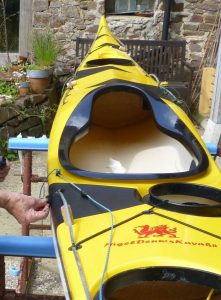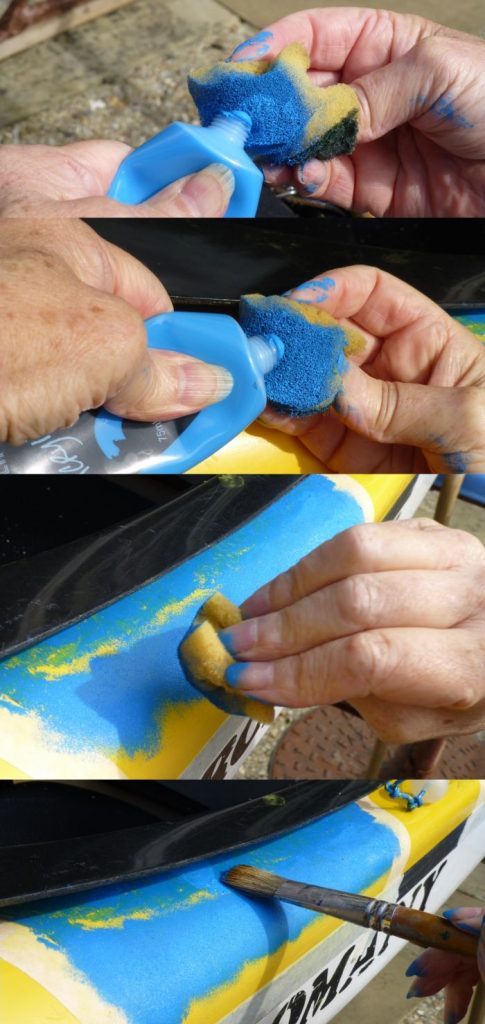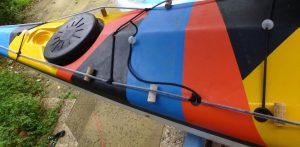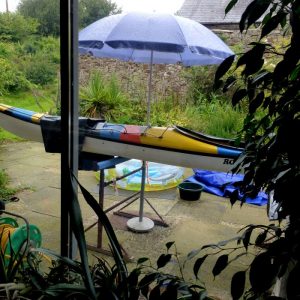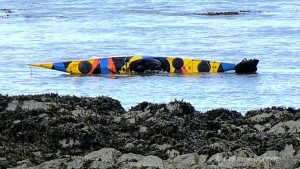Dazzle Camouflage on a Kayak Using Acrylics
Here’s a video of painting the bright patterns on this sea kayak, showing how it was painted and finishing with a Greenland roll – by the owner of the kayak, not the artist!
Video Painting a Kayak
Painting Using Acrylics
This sea kayak was painted mainly using a sponge and in awkward places, a brush. You might wonder what influenced the style and choice of colours, and the answer is that it developed along the way. Disruptive camouflage, known as ‘Dazzle pattern’, that was used on some wartime ships was inspiring further development of the pattern on the kayak.
The story began with a simple idea.
Finished in strong bright yellow, the owner wanted to make it look a bit different, the sea kayak looked just like every other and was hard to spot in a gathering of paddlers.
They started with the Black triangles.
The shapes were masked up and sanded with a fine sandpaper to give a slight key.
The Black Acrylic artist paint was used neat, squeezed on to the sponge and dabbed on rapidly, starting in the middle of each triangle and working outwards towards the edge of the masking tape.
The sun was hot and drying the paint quickly. The criss-cross ropes had to be held out of the way and off the surface as it dried. Wine corks were wedged under the rope in stages as it dried.
Start painting in the middle.
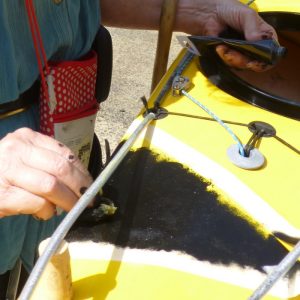
The kayak was not used for a couple of days, to allow the paint to cure. It soon got its first test in the sea and the paint was surprisingly tough, in spite of doubts about how it would hold up. The slightly rough finish produced by sponging was pleasing too.
A few weeks passed and then they thought of adding blue to the kayak. The paint had stood up to paddling in the sea and practicing Greenland rolls, so they were confident about using artist acrylics.
Painting blue with sponge and brush
The pink was added later, mimicking a variation of the camouflage known as ‘Dazzle pattern’, that some wartime ships had used.
The yellow kayak with black, blue and pink paint, close-up of the stern.
Enough pink to complete the painting had to be mixed in a small bowl using vermillion and white, while keeping the colour vibrant and strong.
The changeable weather meant they had to work under an umbrella and protect the wet paint from splashes.
Kayak paint job under the umbrella, viewed from the Studio
The kayak went on to do some dazzling Greenland rolls in the waters around North Devon.
The video ends with a clip from the Greenland roll practice at Lee Bay in the Dazzle Painted Kayak with a Greenland paddle.
Kayak rolling shows the colours
The paint used thoughout were Outlines acrylic paints and it will be interesting to see how long it lasts. They will doubtless have to touch up scratches from time to time, but that would be expected on any boat.
The preparation of the surface will make a difference and whether there was sufficient ‘key’ to make the paint stick. I would usually recommend a sandpaper of about 250 grit on smooth surface such as plastic and coated fibreglass, and make sure all sanding dust is removed before painting.
This is quite a departure from our imagined use of our paints. We’d love to know if you have used acylics in unusual circumstances and you can tell us in a comment below!

